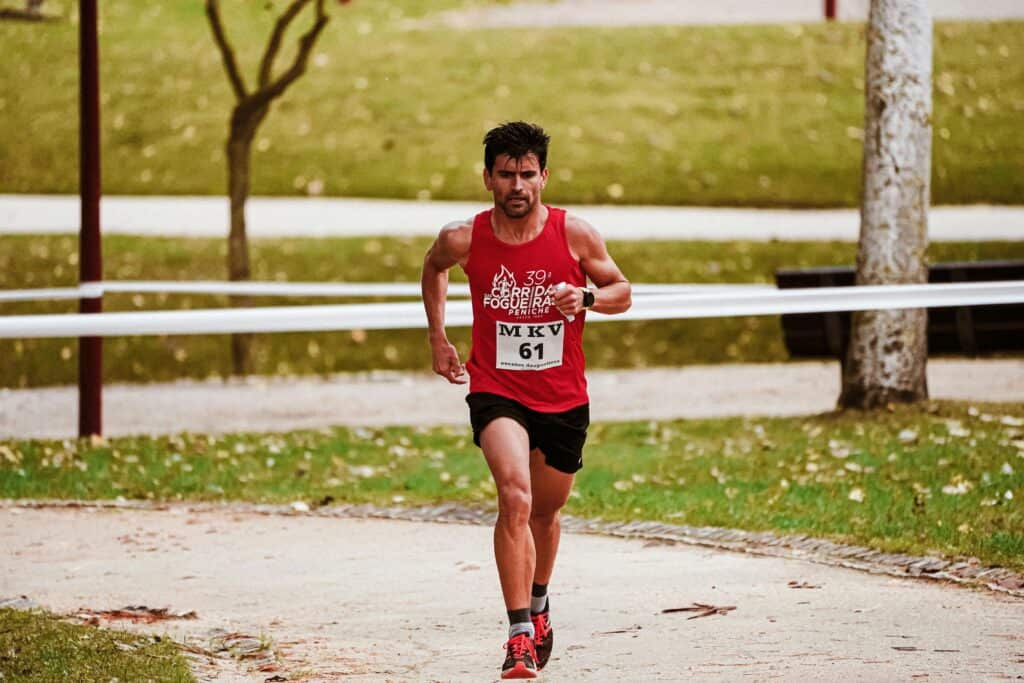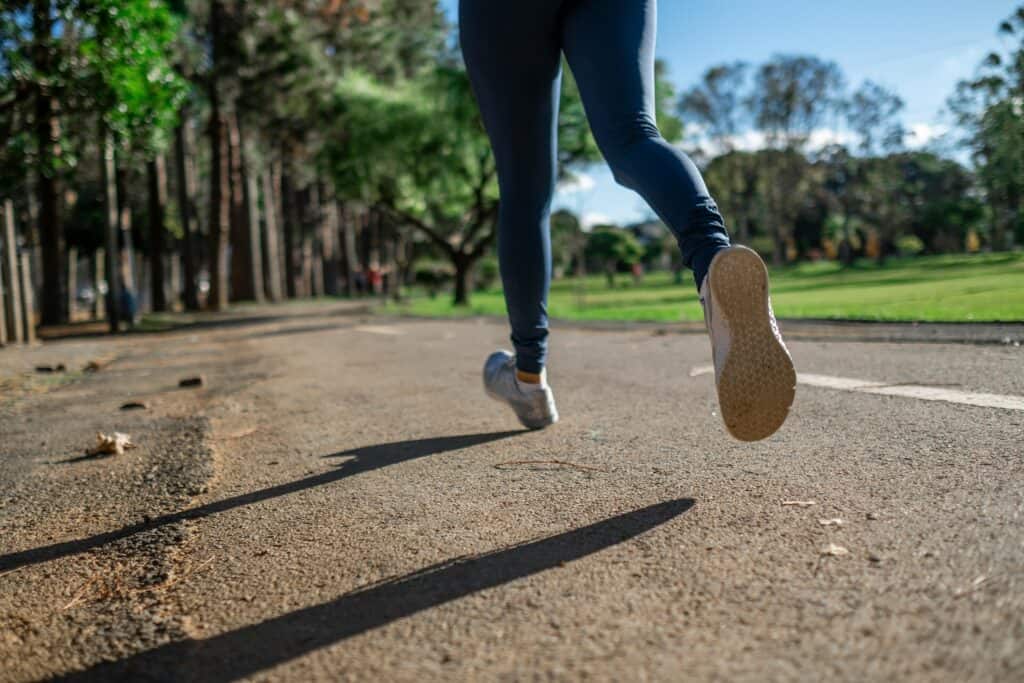This comprehensive guide provides a simple yet effective approach to developing proper running form for long-distance runners. Whether you’re training for a marathon, ultramarathon, or any other endurance event, mastering the fundamentals of efficient running technique can significantly enhance your performance, reduce the risk of injury, and make your runs more enjoyable. In this article, we’ll cover the key elements of proper running posture, arm swing, stride length and cadence, foot strike, and breathing techniques to help you become a more efficient and sustainable long-distance runner.
Key Takeaways
- Proper running form is crucial for long-distance runners to improve efficiency, reduce injury risk, and enhance performance.
- Maintain an upright posture with aligned head, shoulders, and engaged core muscles.
- Develop a relaxed, efficient arm swing to counterbalance leg movement and improve balance.
- Find your optimal stride length and increase cadence to run more efficiently.
- Adopt a midfoot or forefoot strike to reduce impact and improve ankle flexibility and knee drive.
- Incorporate rhythmic breathing patterns to optimize oxygen intake and running economy.
- Dedicate time to practicing form-specific drills and gradually improving your running technique.
Introduction to Proper Running Form
As a distance runner, the importance of proper running form cannot be overstated. Your running technique can have a significant impact on your overall performance, efficiency, and injury risk. By adopting an optimized running form, you can improve your economy of movement, reduce the stress on your body, and enhance your endurance capacity.

Why Proper Form Matters for Distance Runners
Proper running form is crucial for distance runners because it directly affects your running economy, which is the measure of how efficiently you utilize oxygen during your runs. By maintaining an efficient, optimized running technique, you can improve your overall performance and reduce the risk of injury.
Benefits of Optimized Running Technique
When you focus on developing and refining your running form, you can experience a variety of benefits that will significantly improve your long-distance running experience. Some of the key advantages of an efficient running technique include:
- Improved running economy and reduced energy expenditure
- Decreased risk of overuse injuries due to reduced impact and stress on your body
- Enhanced overall running performance and endurance capacity
- Increased running efficiency and sustainability over long distances
By understanding the importance of proper running form and incorporating proven techniques into your training, you can become a more efficient and injury-resistant long-distance runner.
Proper Running Posture
Maintaining proper running posture is fundamental to efficient long-distance running. This includes aligning your head and shoulders in an upright position, and engaging your core muscles to stabilize your body. By adopting this proper running posture, you can minimize energy leaks, improve your running economy, and reduce the risk of injury.
Head and Shoulder Alignment
The alignment of your head and shoulders is crucial for maintaining optimal distance running biomechanics. Keep your head up, eyes focused straight ahead, and your shoulders relaxed and level. This upright head and shoulder alignment helps to promote efficient running form and minimize unnecessary tension in your upper body.
Upright Torso Position
Maintaining an upright torso position is essential for proper running posture. Avoid leaning forward or backward; instead, keep your torso upright and centered over your hips. This upright torso position helps to promote better core engagement and overall body alignment, leading to improved distance running biomechanics.
Engaging Core Muscles
Engaging your core muscles is crucial for maintaining stability and balance during your runs. Focus on keeping your abdominal muscles engaged throughout your stride, and avoid letting your hips or pelvis sag. This core engagement helps to provide a solid foundation for your running form, enhancing your overall distance running biomechanics.

Efficient Arm Swing
The way you swing your arms can have a significant impact on your running efficiency and overall performance. A relaxed, efficient arm swing can help you maintain better balance, generate more power, and improve your running economy. In this section, we’ll discuss the key principles of an effective arm swing, including maintaining a relaxed arm motion and using your arms to counterbalance the movement of your legs. By mastering these techniques, you can enhance your running form and become a more efficient long-distance runner.
Relaxed Arm Motion
Maintaining a relaxed arm motion is crucial for efficient running arm technique. Avoid clenching your fists or tensing your shoulders, as this can lead to energy leaks and disrupt your overall distance running biomechanics. Instead, focus on keeping your arms loose and your hands relaxed, allowing them to swing freely in a natural rhythm that complements the movement of your legs.
Counterbalancing Leg Movement
The arm swing counterbalance plays a vital role in maintaining proper running form. As your legs move forward, your arms should naturally swing back, and vice versa. This counterbalancing motion helps to stabilize your upper body, improve your balance, and enhance your overall running efficiency. By mastering this technique, you can better harness the power of your legs and transform it into forward momentum.
Stride Length and Cadence
Stride length and cadence are two crucial elements of proper running form for long-distance runners. Finding your optimal stride length and increasing your cadence can help you run more efficiently, reduce the impact on your body, and improve your overall marathon running technique and long distance running form.
Finding Your Optimal Stride Length
Determining your ideal stride length is an important step in developing an efficient running stride. Your optimal stride length is the distance between your foot strike and the next foot strike, and it can vary depending on factors like your height, leg length, and running experience. Experimenting with different stride lengths can help you find the sweet spot that allows you to maintain a comfortable, optimal stride length running and maximize your running economy.
Increasing Cadence for Efficiency
In addition to finding your optimal stride length, increasing your running cadence can also contribute to a more efficient running stride. A higher cadence, often referred to as a “quicker turnover,” can help you reduce the impact on your body, improve your running economy, and enhance your overall long distance running form. Experiment with gradually increasing your cadence, aiming for a range of 170-180 steps per minute, to find the sweet spot that works best for your body and running style.

Proper Foot Strike and Gait Cycle
The way your foot strikes the ground and the overall gait cycle can have a significant impact on your running form and efficiency. In this section, we’ll discuss the benefits of a midfoot or forefoot strike, and the importance of ankle flexibility and knee drive in maintaining a smooth, efficient running gait. By understanding and implementing these principles, you can reduce the impact on your body, improve your running economy, and become a more sustainable long-distance runner.
Midfoot or Forefoot Strike
Unlike the traditional heel-striking pattern, a midfoot or forefoot strike can offer several advantages for distance running biomechanics. This foot strike allows for a more natural and efficient landing, reducing the impact forces on your body and promoting a smoother, more fluid gait cycle. By making contact with the ground closer to the midline of your foot or even on the balls of your feet, you can enhance your running economy and reduce the risk of certain overuse injuries.
Ankle Flexibility and Knee Drive
Maintaining ankle flexibility and incorporating a strong knee drive are crucial elements of proper running form. Flexible ankles enable a more natural and compliant foot strike, allowing your feet to absorb the impact and transition through the gait cycle with greater ease. Simultaneously, a powerful knee drive helps to propel you forward, contributing to a more efficient and economical distance running technique.
Breathing Techniques
Proper breathing techniques are essential for long-distance runners, as they can help you maintain better oxygen intake, improve your running economy, and enhance your overall endurance. Developing a rhythmic breathing pattern is a crucial aspect of efficient long-distance running.
Rhythmic Breathing Patterns
One of the most effective breathing techniques for endurance running is to establish a consistent, rhythmic breathing pattern. This involves synchronizing your inhalation and exhalation with your stride. A common approach is the 2:2 or 3:3 breathing pattern, where you inhale for two or three steps and exhale for the same number of steps.
By adopting a rhythmic breathing approach, you can ensure that your body is receiving a steady supply of oxygen while also helping to regulate your pace and energy expenditure. This can lead to improved running economy, reduced fatigue, and enhanced endurance during your long-distance runs.
Experiment with different breathing patterns and find the one that works best for you based on your running speed, terrain, and personal preferences. Consistent practice and attention to your breathing can help you become a more efficient and resilient long-distance runner.
Training and Drills
Developing and refining your running form requires consistent practice and the incorporation of targeted drills and exercises. By dedicating time and effort to improving your form, you can become a more efficient and injury-resistant long-distance runner.
Incorporating Form Drills
Integrating form-specific drills into your training routine is a crucial step in enhancing your running technique. These drills can help you develop better proprioception, improve your running biomechanics, and ingrain the proper movement patterns. Exercises like high knees, skipping, and foot-strike drills can be especially beneficial for long-distance runners, as they focus on developing the essential elements of efficient running form, such as leg drive, ankle flexibility, and midfoot or forefoot striking.
Gradually Improving Technique
Improving your running technique is a gradual process that requires patience and consistent practice. Start by focusing on one or two key elements of your form, such as maintaining an upright posture or increasing your cadence. Once you’ve mastered those aspects, you can gradually incorporate additional form-related adjustments into your training. This stepwise approach will help you build a solid foundation and prevent overloading your body with too many changes at once. By gradually improving your running technique, you can become a more efficient, economical, and injury-resistant long-distance runner.
For more information check out: Stay Safe & Fit: Proper Running Form For Injury prevention
